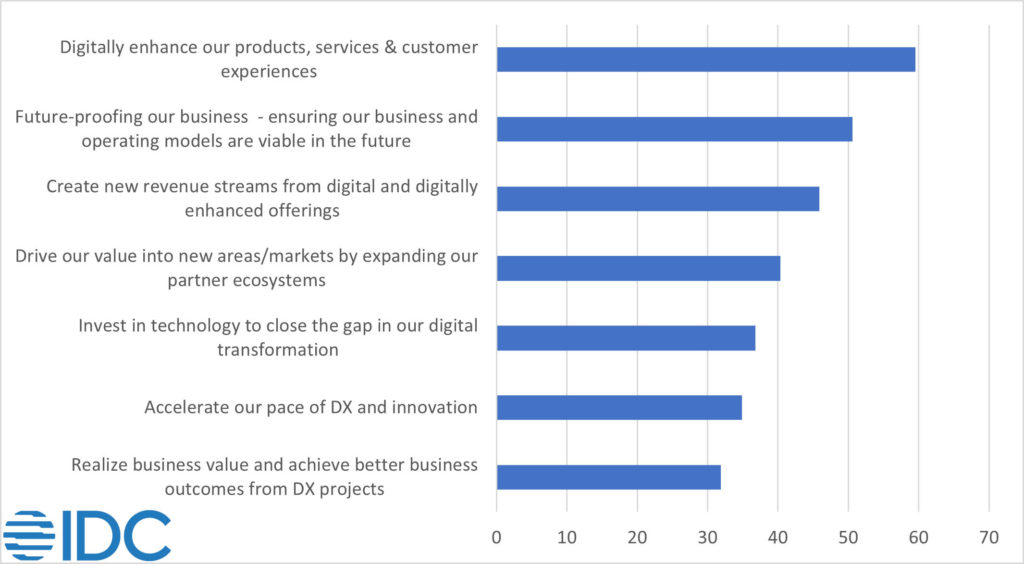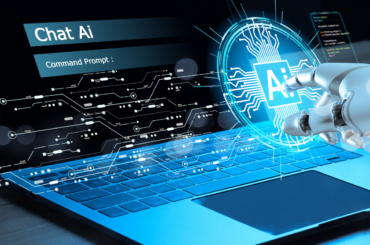Read IDC’s new eBook, Future of Industry Ecosystems: Shared Applications, to learn how to how to maximize data, optimize demand and solve problems with shared applications.
Digitally enhancing products, services, and customer experiences is the top initiative in 2021 for organizations across industries, as is working more closely with industry ecosystem partners for open innovation and meeting customer needs (see Figure 1). Companies within industry ecosystems are coming together with their respective knowledge to co-innovate and blur the edges of traditional organization offerings. Much of this co-innovation will produce new applications in support of digital transformation, product innovation, and customer, consumer, citizen, or patient engagement initiatives.
Figure 1: What are your organization’s top goals for 2021-2022?

Source: IDC’s COVID-19 Impact on IT Spending Survey, November 2020
When organizations state that they will create new digital products and services, this is referring to applications and/or complementary services that meet customer needs and improve decision making. If there is anything that the pandemic has taught us, it is that disruption can happen anytime and customer needs are dynamic, so organizations need to be ready. An important part of this is having the right applications that can be quickly and flexibly developed either internally or in concert with ecosystem partners.
Having that external “bench” of application development support, and ongoing collaboration with other ecosystem participants, is critical to achieve this resiliency. Software initially enables an organization’s products and services and the way that it operates, and the ecosystem can further surround this with more software and services to optimize a blended physical/digital experience and provide improved customer experience. This is what Navistar stated on a recent IDC podcast, speaking about its increasingly software-rich trucks and their complementary industry ecosystem. Iterative digital innovation, or software development, working in concert with their ecosystem, is a mission-critical initiative to the company now and in the future.
A Shared Application Approach Is Needed for Data, Efficiency, and Resiliency
The amount of digital data worldwide will grow by a CAGR of 22.9% through 2025, according to IDC’s 2021–2025 Global DataSphere forecast. The deluge of data that every company is contending with, from connected products, assets, processes, and customers, is difficult to leverage without the applications in place that enable collation of information and rapid decision making. Often, this collation includes interrogating multiple related data models to make connections across organizational domain and ecosystem participants; see market and ecosystem trends and needs, and sense quality, safety, or service issues before they occur.
Flexibly and securely viewing trusted data in context through shared applications across an industry ecosystem also enables process and governance improvement and optimal usage of human, asset, operational, and financial capital. This also empowers organizations to “master economies of intelligence,” building off our future of intelligence research. By economies of intelligence, we mean an organization’s ability to synthesize information and learn over time. The primary organizing application segments that industry ecosystems could and are developing together include the following:
- Industry-specific processes that support innovation, supply chain, operation, quality and safety, administration, customer experience, and service
- Regulatory compliance for the knowledge, validation, and reporting required to stay up to speed, meet quality standards, and keep business processes moving forward
- Digital joint ventures, where ecosystem participants (often competitors) co-develop applications that support operations, safety, or service
The data explosion and demand for applications from ecosystem participants and customers, consumers, citizens, and patients require a mix of internally and externally developed applications. Although there may be an internal software development team working on strategic, high-value projects, IDC predicts that, by 2025, 80% of code in the apps and services that enterprises develop will be from external sources, up from just 30% now. From wave 1 of IDC’s February 2021 Future Enterprise Resiliency and Spending Survey, the mean number of new apps developed in 2020 were 4.1 in-house and 4.55 third-party developed; plans for 2021 are in the same range. While the team of software developers will grow at most organizations today, however, it will likely be in concert with an external, industry ecosystem of approved software developers (could be from app dev marketplaces, service providers and systems integrators [SIs], or individual contributors) that work together to provide value and lower cost.
In some cases, this externalization will be about handing over more work to traditional SIs or other service providers but increasingly also about leveraging other industry ecosystem software development resources. Balancing the supply- and demand-side economies of scale will be crucial to optimize development resources and monetize shared applications.
A Connected, Automated World Takes an Industry Ecosystem
IDC predicts that, by 2025, a quarter of Fortune 500 companies will become software producers to digitally transform their organization. These applications and/or related code, however, are increasingly procured from external sources, often shared with industry ecosystem partners or jointly developed, spanning innovation, operation, and customer experience. The economics of cloud make it less expensive to take this approach than expand an internal developer group, although most organizations are maintaining their internal group to ensure software efficacy and quality. To learn more about optimizing the applications that support their industry ecosystems, read IDC’s new eBook, Future of Industry Ecosystems: Shared Applications. Click the button below to learn download the eBook now.




